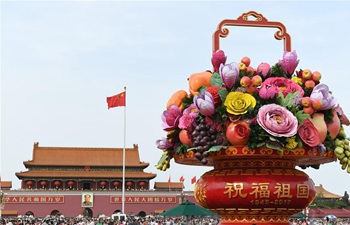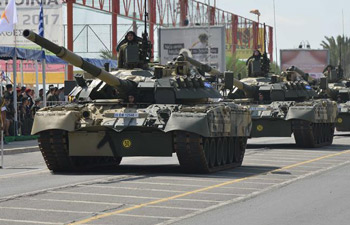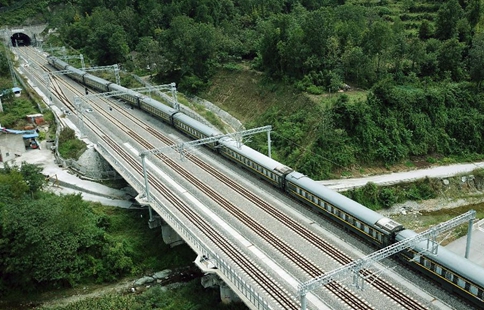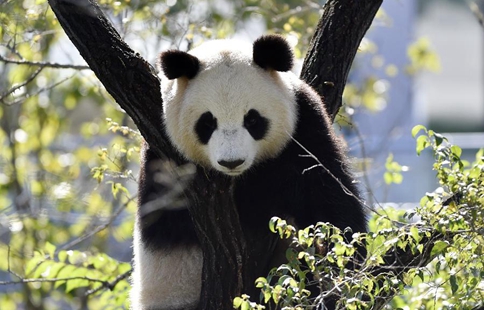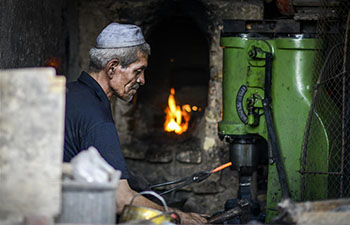
Photo taken on July 14, 2017 shows locally sourced beef from Cameron, Texas, at a local market in Houston, the United States. The United States has reached agreements with China on final details of a protocol to allow it to export beef toChina, the U.S. Department of Agriculture said on June 12. In 2003,China shut its market to American beef after a case of bovine spongiform encephalopathy, also known as Mad Cow Disease, was detected in the United States. (Xinhua/Yi-Chin Lee)
by Peter Mertz
DENVER, the United States, Oct. 1 (Xinhua) -- Two months after China and the United States reached a deal to reopen Chinese markets for U.S. beef in July, as part of the 100-day action plan to boost economic cooperation, American beef was back on China's menu.
"By getting our foot in the door we hope to develop a long lasting and mutually beneficial relationship with China," said Craig Uden, President of the National Cattlemen's Beef Association.
The year after the 2003 ban took place amid concerns over mad cow disease, American beef exports to China dropped from 3 billion U.S. dollars to 1.1 billion U.S. dollars.
By 2018 - market insiders predict beef sales will be 3.8 billion U.S. dollars to China alone - with no limit in sight.
"It's impossible to overstate how beneficial this will be for America's cattle producers," Uden said.
Out of the nearly 170 billion U.S. dollars in U.S. exports to China in 2016, food, feed, and drinks made up only 20 billion U.S. dollars, according to the USDA, revealing lots of room for growth in the food sector.
"Quality beef is what the Chinese consumer wants," Richard Phillips told Xinhua.
Phillips, General Manager of Agri-Product and Foods Department of China Certification & Inspection Group (CCIC) North America, is busier than ever these days inspecting and certifying U.S. beef farms to do business with China.
"Fourteen years ago, China's economy was still developing - and we've grown at such a rapid rate that lots of people have money and have become rich," Phillips told Xinhua Friday, adding "they want good products from the United States."
Currently, China is importing most of its beef from Australia, according to Phillips.
Quality concerns and a consumer demand that exceeds domestic production by 25 percent in China give a good chance for U.S. President Donald Trump.
U.S. Commerce Secretary Wilbur Ross claimed last month that, "President Trump is doing more to improve the U.S.-China relationship than any president in decades," and cited the beef deal as "even more concrete progress."
"The Trump government doesn't want a trade imbalance," Phillips said, noting that U.S. soybean exports to China currently total 13 billion U.S. dollars and the sky is the limit with beef.
So in a headline last week, Agri-Pulse, a company based in Washington D.C. providing weekly report of the latest in agricultural information said, "meat packers are lined up to do business with China."
But some producers told Xinhua they will proceed with caution.
"Our product is very perishable and it poses a big impediment to ship to China," Taylor Smith with the Kansas City Steak Company told Xinhua.
Kansas City currently only ships inside American borders, but the prospect of selling to China is alluring, despite the potential complications, Smith said.
"I think the Chinese-American beef relationship will work," said California businessman Glenn Nemhauser.
Texas is the largest producer of beef in the United States, followed by Nebraska, Kansas, and California.
Interestingly, Phillips has been busy inspecting facilities in 10th-ranked Montana, where many cattle ranches have expressed interest in selling to China.
"It's a really smart place for China to put in investment and to partner with Montana to have a really good packing industry and processing plant here," Fred Wacker vice president of the Montana Stockgrowers Association said at a roundtable meeting early September organized by U.S. Senator Steve Daines in Bozeman of Montana.
Wacker argued that would help bring down logistic costs and guarantee stable supply of high quality beef to China, a win-win deal for both sides.
But none are as seasoned as Arkansas-based Tyson Foods, who started doing business with China in 1971, even before President Richard Nixon's historic 1972 visit.
In 2001, Tyson merged with Shandong Food to build a modern, cutting edge poultry processing facility in Shandong Province.
In 2008, Tyson built modern processing facilities - according to global production standards - in Jiangxi Province near Shanghai.
And the following year, Tyson initiated another joint venture in Shandong with three poultry plants - providing quick service restaurants and retail outlets with chicken, as part of Tyson Rizhao in Juxian Industrial Park.
Tyson knows how to do business in China, and company executives were ecstatic at the already increased business across the Pacific. In 2015, Tyson, hiring 115,000 people who work at more than 300 facilities worldwide including 90 in the United States, had 42 billion U.S. dollars internationally in revenues, up from 36 billion U.S. dollars in 2014.
"Our top people just returned from China, and we're incredibly busy there," a spokesperson told Xinhua Friday, not ruling out significant expansion in China for the food-processing giant.






